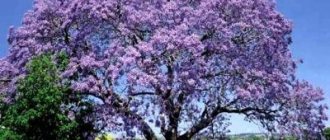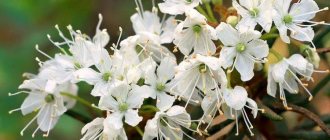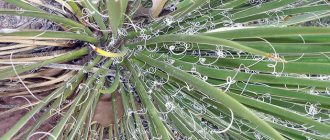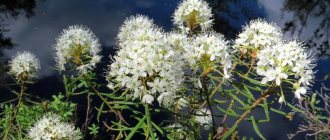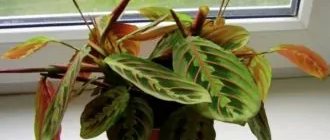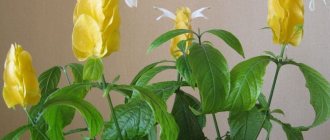On the damp banks of rivers in the tropics of Brazil and South America, an unusually beautiful tree grows - the jacaranda. This is a plant from the Bignoniaceae family. They say it brings good luck. Often, in the house where a child was born, local residents plant a jacaranda, the so-called violet tree.
In Australia, the jacaranda flowering period is from October to November. This time coincides with the end of the school year and the beginning of exams for schoolchildren and students. In this regard, residents call it examination. A blooming panicle falling on the head will bring good luck to those going to the exam.
Rosewood is an evergreen tree of medium or large size, valued not only for its decorative effect, but also for its wood. There are about fifty species of this plant.
Photo gallery
Only mimosolia jacaranda can be grown indoors. It is better to keep it in rooms with a high ceiling, as it reaches a height of two meters. Jacaranda trees must be pruned before growing. More suitable for greenhouses and “winter gardens” than for a standard room in a Russian apartment.
It is non-toxic, does not affect air purification, and does not emit any harmful substances. Does not belong to the class of poisonous, not harmful to children, adults and pets.
Outwardly, it is often compared to sakura, jasmine and lilac. But in indoor conditions you will hardly find any flowering, so it resembles an ordinary plant with a beautiful stem and graceful leaves.
Jacaranda (violet tree) - brief description, history of appearance
In its natural habitat, the plant can be seen in Australia, some regions of Asia and South America, but it is most common in Brazil. Jacaranda mimosifolia, as it is also called, or rosewood tree, belongs to the Bignoniaceae family.
violet tree
Additional Information. The name means "hard wood" in Portuguese. In Brazil the tree is also called Black Pui.
Jacaranda is an evergreen tree; in nature it can grow up to 30 meters in height, but 2-meter shrubs are also found. The leaves are pinnate and fern-like, and the flowers are bell-shaped and purple in color. However, some varieties may be white.
In addition to its decorative qualities, the plant also finds practical use. Its wood is used to make furniture, musical instruments and souvenirs.
Unfortunately, this amazing tree does not grow in Russia. It is impossible to provide it with a climate similar to a tropical one. You can see the jacaranda in the Botanical Garden of Crimea, where conditions are created for it that are as close to natural as possible.
For reference! Although the plant is often called jacaranda, jacaranda, and even jacaranda, the second option is correct.
How does it bloom?
In wild conditions, jacaranda grows up to 15 meters, it has a lush crown and wide feathery leaves that have elongated bright green plates. The tree has large inflorescences with five dozen purple or bluish flowers with jagged calyxes and curved bell-shaped corollas, which are slightly lowered and bent.
Mimofolia jacaranda has violet-bluish inflorescences with small calyxes. The plant with flowers can be seen more often in October and early November. In indoor conditions, it blooms twice a year: in spring and autumn. Varieties of this species, Magdalena and Delta, are also used for cultivation.
Types and varieties
In nature, there are more than 50 species of violet trees and shrubs. But only two species have been cultivated for indoor maintenance: the mimofolia jacaranda and the jasmine or fluffy jacaranda (jacaranda tomentosa).
Fluffy jacaranda (felt)
Fluffy jacaranda (felt)
At home, in South America, its height can reach 15 meters. The complex pinnate leaves are composed of 8 lobes. The flowers of jasmine jacaranda are smaller, collected in paniculate inflorescences. Shades range from golden to purple. Young specimens are grown at home, since as the plant matures, it loses its attractiveness.
Jacaranda mimosifolia
Jacaranda mimosifolia
Other names: Round-leaved or oval-leaved Jacaranda (Jacaranda ovalifolia). On the banks of rivers in Brazil, Argentina and Bolivia it grows in the same way as the previous species. 15-20 meters high, although in room conditions it reaches only 2-3 meters. The leaves resemble the leaf blades of a mimosa, very large, feathery, located far from each other opposite. Elongated in shape, with pointed tips.
It blooms very profusely and amicably with blue or purple flowers. Paniculate inflorescences are collected from buds 5 cm in length and 3 cm in diameter.
This type of plant is the only one that can be grown at home. Mimosal jacaranda has two varieties for growing at home - Delta and Magdalena.
Magdalena
The variety is classified as a fast-growing plant. In indoor conditions it reaches a height of no more than 3 meters. The leaves, like those of all its relatives, are pinnate, complex, and unpaired. Painted in light green tones. It is very difficult to achieve flowering; it can only bloom in the open ground of greenhouses or greenhouses. From the pot, the plant should be transplanted into open soil after the plant reaches 2 meters.
Often used in offices and shops.
Delta
Jacaranda delta is a deciduous ornamental plant for growing indoors. The leaves are fern-like, very beautiful, openwork, delicate light green in color, and grow up to 45 cm in length. With proper care and placement, the plant reaches 2 meters.
Looks great in well-lit offices, hallways and lobbies.
Signs and superstitions
It is believed that jacaranda has a strong magical effect, so keeping it at home is extremely beneficial for the family. This is a tree that gives beauty and brings good luck. It has a number of properties that cleanse the aura and fill the space with positive energy.
It brings prosperity and prosperity. The violet tree purifies negative thoughts and instills harmony and tranquility in the soul. However, for some people it causes apathy and drowsiness.
According to Feng Shui, it is better to place jacaranda in wide spaces near windows. It is not advisable to place it next to the bed and resting place, in the kitchen or in the office.
Signs associated with the flowering of the violet tree are also common. This process promises well-being, brings prosperity to the house and may indicate an imminent addition to the family.
When purchasing a plant, pay attention to your interior. Jacaranda cannot be in a cramped and narrow space; it needs space. Don’t forget to move it into the shade in hot weather, otherwise the leaves may soon turn yellow.
When purchasing, pay attention to the leaves - if they are yellowish at the edges, and the leaves themselves are slightly curved, then this plant may soon wither.
Choose a violet tree with bright green leaves that have a glossy sheen.
Jacaranda tree: application in design
A jacaranda tree grown from seeds at home rarely blooms, so you can’t count on it to bloom. It is used as an ornamental plant, whose lush, openwork crown looks great even without inflorescences.
Jacaranda as Bonsai
The peculiarity of the flower is that it sheds its foliage in winter, and with age it begins to completely get rid of it in the lower part of the trunk, which gradually becomes woody. Professionals have learned to use this characteristic feature for decorative purposes, creating bonsai from jacaranda. With proper pruning, a lush bush transforms into an incredibly beautiful, discreet bansai.
Is Jacaranda suitable for bonsai?
The plant is used for cultivation using Japanese bonsai technology. This allows you to control the growth of the crown and leaves, as well as create your own miniature garden. There is even a separate variety of jacaranda, “Bonsai Blue,” which does not reach a length of more than 75 centimeters. For cultivation, the following conditions must be met:
- in the first year you cannot prune it;
- in the second year, cut to 10 cm and wait for side shoots to appear;
- then pinch the jacaranda, trimming the leaves and crown;
- to form the crown, you can use soft wire, which must be removed after 3 months;
- It is better to cut off all large leaves;
- Jacaranda will branch worse when standing in the shade.
Landing
The soil mixture for plants should be moderately nutritious, light, and well-drained. A substrate made of humus, peat, or river sand is suitable. It is useful to add crushed charcoal.
Planting is done by seeds and cuttings. To obtain seedlings, seeds are deepened a few cm into moist soil and placed in a warm, well-lit place. It is advisable to cover the container with soil with film. The seedlings emerge after 3–5 weeks. To speed up germination, it is recommended to soak the seeds for 1 day in warm water or a special phytohormone solution before planting. In this case, shoots will appear in a week. Within 10–15 days, the sprouts reach 4 cm, and the first pair of leaves appears on them. After another month, the plant acquires dissected pinnate leaves, and they can be moved to a permanent location. It is better to immediately choose a spacious container to ensure freedom for the fast-growing root system. Containers made of ceramic, wood or plastic are suitable. At the bottom of the pot you need to lay a thick layer of drainage made of expanded clay, pebbles or crushed brick.
Apical jacaranda cuttings 8–10 cm long are rooted in sandy soil for 5 weeks. Every day, the top layer of the substrate should be moistened with a diffuse stream of water from a spray bottle.
Home care
In summer it is unpretentious and easily adapts to the absence of sun, and in the heat it practically does not dry out. It is recommended to keep it at a temperature of - 13 °C. In winter, it needs a cool room, with a temperature of about 7 °C. Sudden changes in temperature are not allowed, as the plant is in “hibernation”.
High humidity of at least 60% is desirable; daily spraying with soft water at room temperature is required. In winter, you need to water less often, up to once every 3-4 weeks.
The violet tree loves light, so it can be placed in a window all day. Young plants can exist in light partial shade. In winter, additional light sources are needed.
Growing conditions for indoor jacaranda
Since it is almost impossible to achieve flowering from jacaranda, it is more appropriate to perceive it as an ornamental foliage plant and approach cultivation accordingly. After all, all the efforts to organize a rest period are still unlikely to pay off. But even so, you need to find the right place for it.
Lighting and placement
Jacaranda loves a bright, but not sunny place and long daylight hours. Soft morning or evening sun (at least 3-4 hours) is suitable for it; it is better to protect the plant from daylight with a diffusing screen. Western window sills can safely be considered an ideal place.
In winter, lighting should be increased as much as possible. Ideally, you need to add additional light to the jacaranda, extending the daylight hours to 12-13 hours. The intensity of lighting in the cold season should correspond to southern window sills. Only the brightest and most stable lighting all year round allows old plants to bloom.
Jacaranda needs to be regularly rotated in relation to the light source for uniform development.
Read about jacaranda also in the article 8 capricious indoor plants that beginners should grow.
Temperature and ventilation
Jacaranda may love the high humidity of the tropics, but it does not tolerate heat in a potted format. It is best to grow it in moderate temperatures, in summer - from 21 to 25 degrees.
Winter mode - with a temperature of about 16 degrees. The minimum temperature that jacaranda can withstand is 12 degrees Celsius, but indoor plants most often suffer already at 15 degrees. If it is possible to compensate for changes in lighting and constantly keep the jacaranda in high humidity, a warm winter is also acceptable.
Jacarandas cannot tolerate drafts; they can only be taken out into fresh air for a few days (at night temperatures above 16 degrees).
Western window sills can be considered an ideal place for jacaranda. ©GardenTags
Transfer
To prepare a jacaranda for transplanting you need:
- treat the leaves with a protective spray and trim them;
- prepare a new pot and soil;
- add fresh humus to the soil;
- treat the soil with phosphates.
A transplant may be needed:
- after the purchase;
- because the flower has grown and the pot is cramped;
- due to improper soil;
- due to flower diseases.
Replanting during flowering is undesirable, but is possible only if the plant has been attacked by pests and are beginning to approach the root system.
Possible problems
If there are violations in the care of home jacaranda, it becomes less resistant to pests and diseases. In this case, problems such as:
- Rot forms on the root system . Excessively abundant watering and poor drainage layer. Replant the diseased bush, while cutting out all the affected roots. For planting, a soil mixture is used, which is mixed with brick chips, vermiculite and perlite.
- Yellowing of foliage . The plant feels a lack of iron. Add this element to the substrate.
- Flying leaves in spring . Natural process.
- Pests . A scale insect, spider mite or whitefly may settle on the tree. To get rid of them, use suitable insecticidal agents.
Growing and Reproduction
Jacaranda is grown in 2 ways:
- seeds;
- cuttings.
What needs to be done for good seed germination?
- Growing from seed requires good soil.
- It is necessary to choose suitable soil with proper drainage.
- Use small ceramic pots.
- The temperature during germination should be up to 30 °C.
- You need to stretch small cotton wicks through the drainage and lower them into a container of water.
- The top of the drainage should be covered with soil and a seed should be placed in the center.
- The seed must be sprinkled with a small amount of soil.
- The pot should be placed in a transparent plastic container with a lid or grown in a greenhouse.
- It needs to be exposed to the light.
It is necessary to spray as the soil dries using a spray bottle. Shoots appear after 2-4 weeks.
Propagation by cuttings
- Cut the stalk.
- Dry it for several days in a pantry or other dry, dark place.
- Place in a heteroauxin solution for a day to accelerate root formation.
- Add moist substrate to the planting site.
- Plant the cuttings at an angle of 45 °C, adding peat and fine sand to the mixture.
- Cover with film and keep at 25°C.
Jacaranda care
In total, more than 50 species of jacaranda are known, but only two varieties are suitable for growing indoors: mimosolia, whose leaves resemble mimosa leaves, and fluffy, which is also called jasmonic. Mostly young plants are used for keeping in the room, since adults usually do not have leaves on the lower branches, which reduces their decorative qualities.
Priming
Most gardeners note that the violet tree does not bloom when grown as an indoor flower. Obviously, this is due to the fact that the plant does not have enough space. As the flower grows and develops, it needs to be periodically planted in a larger container, this can be an ordinary ceramic pot or tub.
You need to lay high-quality drainage at the bottom: the bottom layer is broken, crushed brick, and on top is a layer of coarse river sand. To prepare the soil, take 1 part of sand or perlite, peat, humus, leaf soil and 2 parts of turf. You can grind a piece of charcoal and mix it with the rest of the ingredients.
Transfer
Jacaranda is transplanted in several cases:
- after purchasing from a specialized flower shop;
- when the plant has grown and is already cramped in the old pot;
- if the soil was prepared incorrectly last time;
- the plant has been attacked by pests or has been affected by a disease.
It is not advisable to replant a flowering plant. The exception is those cases when the jacaranda has been attacked by pests that can damage the root system.
Reproduction
To obtain new young violet tree plants, two methods of propagation are used.
- Seeds
This is the simplest method that does not require attention and careful maintenance. Take special containers for germination or small ceramic pots. To avoid the need to monitor the moisture of the soil, use rag wicks, which need to be lowered with one end to the bottom and the other end into a container with water. Place drainage compound on the bottom, then a layer of soil. Place one seed in the center. Seeds should be purchased only from trusted producers. Sprinkle a light layer of soil on top, water gently, cover with a clear plastic lid or plastic wrap and place in the sun. For seeds to germinate, they need to create greenhouse conditions: high humidity and temperature. After 2-4 weeks, a sprout should appear above the soil surface, after which the cover (film) must be removed. Until the seedling reaches three months of age, it is not recommended to disturb or replant it.
- By cuttings
Carefully inspect the tree and select young, healthy shoots. Carefully cut cuttings about 8 cm long with a sharp knife or pruning shears and keep them in a dark and dry place for several days so that the cut area dries out slightly. Dip the cuttings in a growth stimulator to speed up root formation. Prepare containers for germination by filling them with drainage and soil, and moisten them thoroughly. Plant the cuttings with a slight slope (about 45º). Cover with film or a transparent plastic bottle, place in the sun and wait for young leaves to appear on the shoot. This will mean that the shoot has taken root and the plant is ready to be transplanted to a permanent location.
Fertilizer and feeding
The plant is very demanding regarding the content of nutrients in the soil. The best fertilizers will be mixtures based on superphosphate and phosphorus. They can be used either dry or as a solution when watering. You can also use organic (bird droppings, humus, peat) and mineral fertilizers (phosphorus, potassium). Fertilizers help strengthen plants and promote rapid growth. During the period of active growth, jacaranda is fed once every 2 weeks. During the rest period, this can be done less frequently or eliminated altogether.
Watering
Adult plants do not require a large amount of water, with the exception of the summer season, when jacaranda actively grows, develops, and blooms. At this time, it needs to be watered with warm, soft water, and the leaves should be regularly sprayed with a spray bottle. In winter, during the dormant period, the tree is watered no more than once a month, but without allowing the earthen clod to dry out completely.
Trimming
In order for the plant to retain its characteristic decorative effect for as long as possible, young shoots are pinched in the spring. In addition, pruning is mandatory before replanting into a larger pot.
Diseases and pests
Jacaranda is quite resistant to diseases and biopests. But this can happen even when grown indoors as a result of improper soil selection, improper care, pests can “move” from neighboring indoor plants, or when you take your “pets” outside to the balcony “to get some fresh air.”
Excessively frequent watering, lack of or incorrectly selected drainage composition can lead to stagnation of water and rotting of the root system. If the grower “forgets” to water the plants while they are standing, they are standing in a draft, they are exposed to cold air, then the leaves begin to turn yellow, curl, and fall off. In these cases, it is necessary to provide the trees with comfortable conditions, good lighting, and adjust the frequency of watering.
A slowdown in growth combined with yellowing of the leaves indicates a lack of iron, magnesium, zinc, sulfur, and an excess of lime in the soil. In this case, the plant needs to be transplanted into a new nutrient soil and fertilized using fertilizers of the appropriate composition.
Pests that can most often affect jacaranda when grown in a winter garden, greenhouse or on an indoor windowsill include: whitefly, aphids, and spider mites. To avoid infection, you need to regularly inspect not only the violet tree, but also other indoor plants located in the immediate vicinity. Moreover, the inspection must be carried out very carefully. Aphids usually attack the tops of young shoots, which leads to slower growth. But whiteflies and spider mites inhabit the lower part of the leaves. In the first case, you can first observe small greenish larvae, and then white midges. In the second there is a thin cobweb entangling the leaves from below.
To combat them, special insecticides are used - pest control agents. As a preventive measure, regularly spray the plants with water and maintain high humidity in the room.
Fertilizer and feeding
The best “nutrients” are fertilizers based on phosphorus and superphosphate. It is also recommended to use lime, but it should not be combined with acidified soil and alkaline fertilizers. It is better to use fertilizers in dry form, but you can add a little con class=”aligncenter” width=”1200″ height=”1200″[/img]
Organic
Manure, bird droppings, peat, silt, sawdust and tree bark, green manure, composts.
Mineral
They are considered excellent assistants when processing plants, strengthen them and provoke rapid growth.
- Potassium.
- Phosphorus.
- Complex mineral fertilizers.
You can buy mixtures of peat and sand, compost, as well as various mineral fertilizers. Among them: “Superphosphate”, “Ammophos”, “Urea” and others.
Kornevin is a cream-colored powder, a small amount is used in dry form, suitable for dipping the end of the cutting when transplanting for better rooting or rapid development of roots.
Heteroauxin is the main phytohormone of plants, promoting active metabolism and preventing rapid leaf fall.
You can prepare fertilizers at home by mixing natural ingredients with mineral ones.
It is necessary to feed during growth once every 2 weeks. It is very useful for jacaranda to use organic fertilizers, alternating them with mineral ones even during the dormant period. Watering
Water the jacaranda sparingly, as it does not like excessive moisture. It needs abundant watering during the period of active growth - from spring to autumn. The water should be at room temperature and soft; do not water it with cold water, as the violet tree may “get sick.” In winter, you need to water less often, and in especially cold months, up to once every 3-4 weeks.
Traditions and beliefs associated with jacaranda
Jacaranda is a plant that has been endowed with magical properties. There is an opinion that the presence of a tree in a room helps to cleanse the aura and energy of the household.
A number of African tribes believe that the Blue Spirit lives in the crown, which helps to make the right decisions in difficult situations. For some nationalities, jacaranda is a talisman for babies.
In the historical homeland of the violet tree, a decoction is prepared from the inflorescences and fruits, which is used in the treatment of intestinal disorders.
Jacaranda or jacaranda is a unique plant that captivates with its blooms of incredible beauty and tenderness. The tree is grown indoors, where it blooms quite rarely. But if you make an effort and create maximum comfort for him, the likelihood of lilac buds appearing will increase significantly.
Diseases
Leaves curl and turn yellow
Possible reasons are dry air and soil, cold, drafts. It is recommended to inspect your jacaranda for pests. If insects are not found, you need to adjust the care and maintenance regime.
Leaf chlorosis
Develops due to high lime content in the soil, poor watering, deficiency of iron, magnesium, sulfur and zinc. Accompanied by yellowing of leaves and slow growth. They are transplanted into nutritious soil and fertilized with fertilizers with a high content of missing microelements.
Root rotting
Lack of drainage, dense soil, excessive watering. Check the condition of drainage and soil. If necessary, replant the plant, stop watering, then water moderately.
What to do before planting a walnut chestnut tree
The correct place to grow the tree also plays an important role. You need to figure out how to plant chestnuts, because unfavorable conditions tend to create unnecessary problems for crops. There are several rules on how to germinate chestnuts:
- keeping seeds in a cold room for several weeks;
- planting in moist soil to avoid various diseases;
- You need to plant at least 5-6 nuts, which should be placed in dug holes in the ground, since not all of them will be accepted. The planting depth of the nut is about 5 cm, and the distance between them is 15-20 cm;
- the holes are covered with the same soil, but with the addition of a small amount of river sand.
Note! Then they will grow on their own. For the winter they will be covered with snow and put into a state of some kind of “hibernation”
Winter option
Rhododendron
Rhododendrons belong to the Ericaceae family. These small trees and shrubs are found throughout the world, but are especially popular in China and Japan. Rhododendron flowers are collected in multi-flowered inflorescences of various colors: pink, purple, red, orange, yellow, white. They bloom in May, and at this time it is impossible to take your eyes off the rhododendron.
In the middle zone, the most winter-hardy and unpretentious rhododendrons are grown: Katevbinsky, Daurian, Vazeya, golden, Caucasian, pointed, Japanese. Only their heat-loving varieties need shelter, and species plants tolerate even harsh winters well.
Recommendations
- ^ a b
Prado, D. (1998-01-01).
"IUCN Red List of Threatened Species: Jacaranda mimosifolia." IUCN Red List of Threatened Species
. Doi:10.2305/iucn.uk.1998.rlts.t32027a9675619.en. Received 2020-06-16. - " Jacaranda mimosyfolia
."
Germplasm Resources Information Network (GRIN)
. Agricultural Research Service (ARS), United States Department of Agriculture (USDA). Retrieved 2008-03-09. - Plant List: A Working List of All Plant Species
, retrieved September 10, 2016 - ^ a b c
Kathleen Norris Brenzel (2007).
Western Garden Book "Sunset"
. Sunset Publishing Group. item 415. - " Jacaranda mimosyfolia
."
www.rhs.org
. Royal Horticultural Society. Retrieved September 25, 2020. - Agroforestry Database 4.0 (Orva et al. 2009)
- "Grafton Jacaranda Festival."
- ^ a b
Edward F. Gilman and Dennis G. Watson2 (November 1993). "Facts about Jacaranda Mimosifolia" (PDF). hort.ifas.ufl.edu. Received 2019-02-21. - Houser, Huell. "#15006 Jacaranda." California Gold
. Archived from the original on 2013-01-12. - Buzz Bertolero (2006-10-06). "Popularity of Jacaranda Trees in the Bay Area." East Bay Times. Received 2019-02-21.
- La Nation - August 28, 2022
- [1]
- lyricsplayground.com
- UQ Centenary 2010 – Jacaranda and sandstone
- "Australians mourn tree that 'failed' university students." BBC News
. 2016-10-31. Retrieved 2016-10-31. - "The University Community Mourns the Fall of the Jacaranda Tree." University of Sydney
. Retrieved 2016-11-06. - ^ a b
"Jacarandas signal purple scare." Chronicle. Retrieved February 29, 2016. - “This is a purple paradise, because exams and Jacaranda blossoms are about to begin!” SA people NEWS. 2014-10-27. Retrieved February 29, 2016.
- "Jacaranda City" ShowMe South Africa. Retrieved February 29, 2016.
